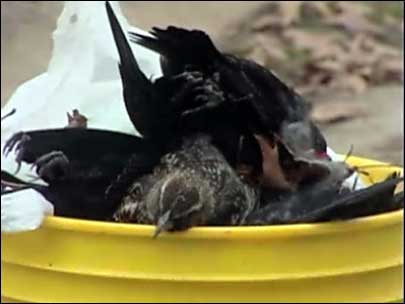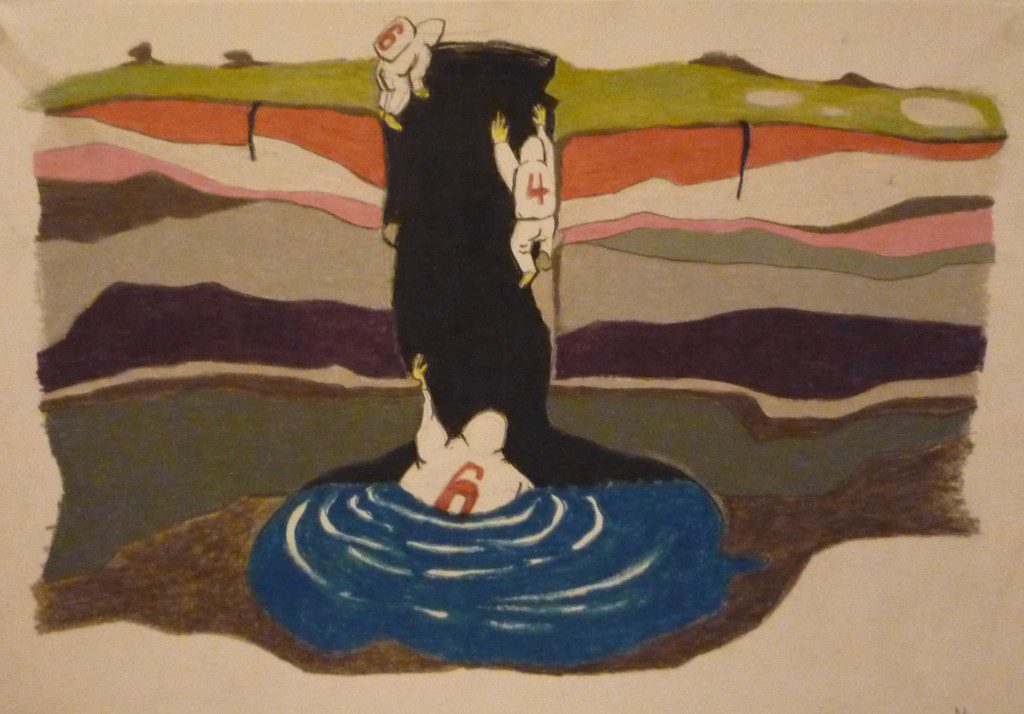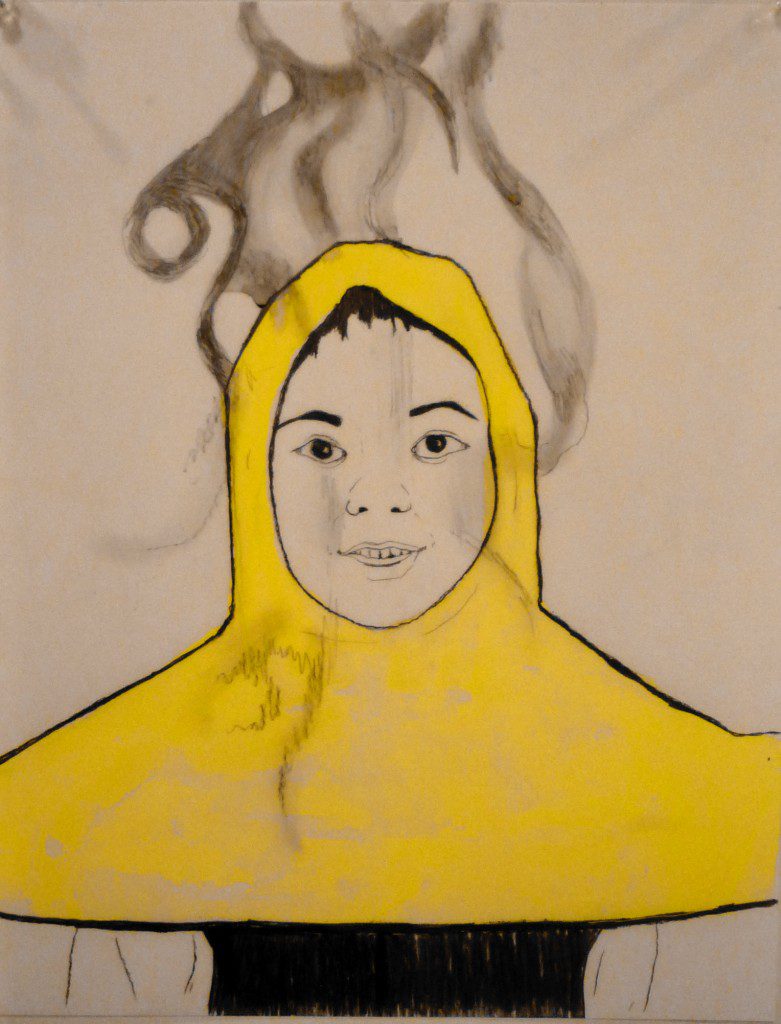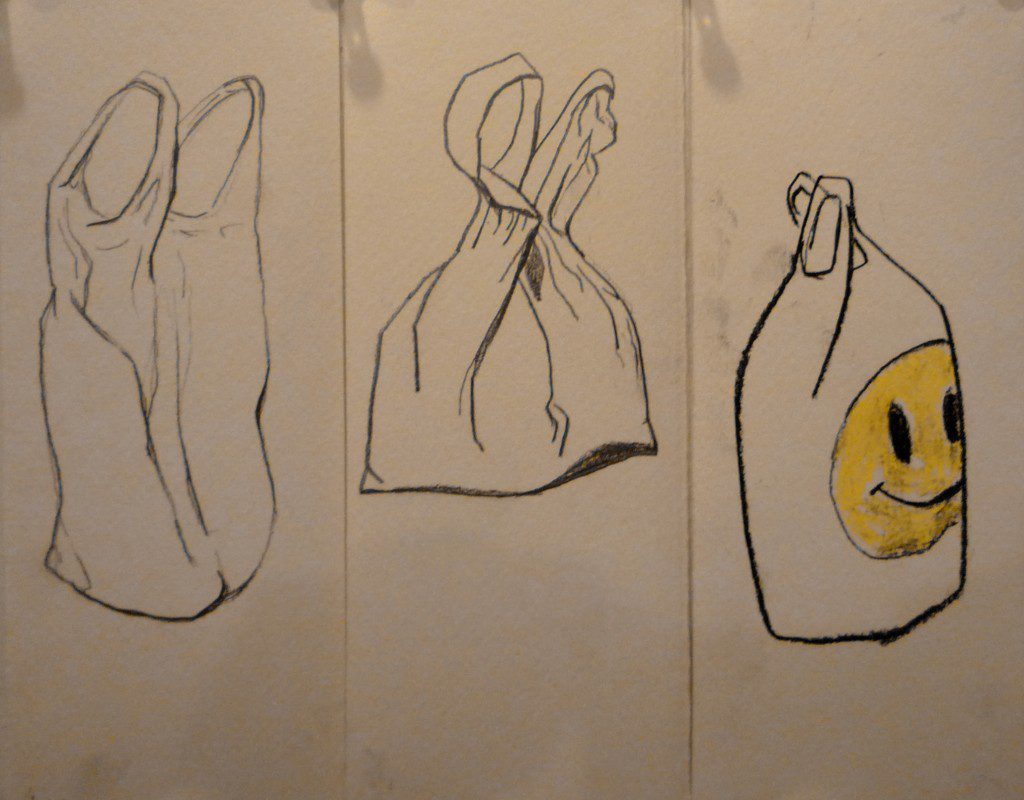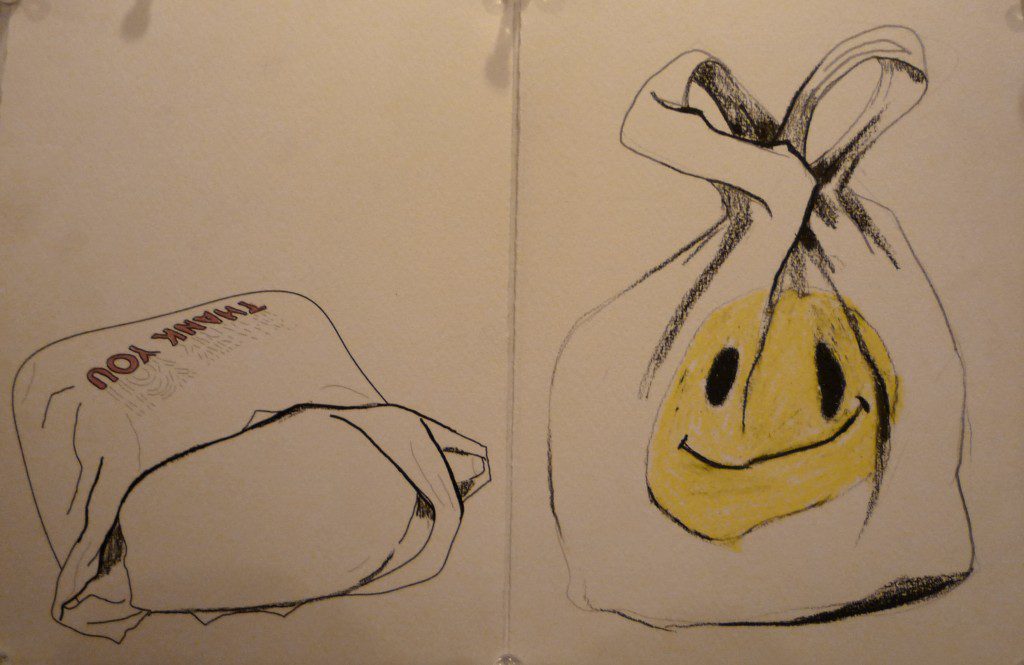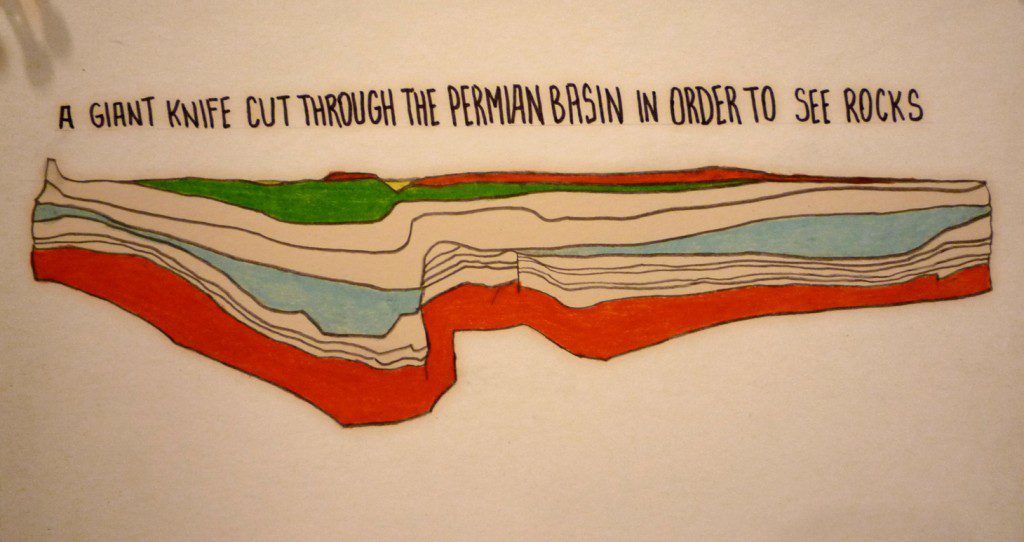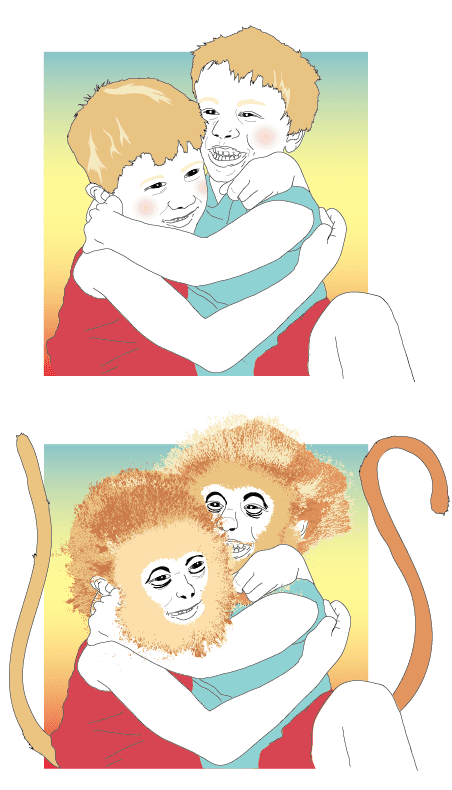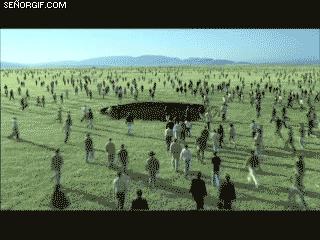Research Journal
-
January 7, 2011
Houston waterway shut for days after beef fat leak
Tags:My comments in (italics)
HOUSTON (AP) — The Coast Guard says a nearly one-mile stretch of the Houston Ship Channel will be closed for at least four days as workers use pitchforks and fishnets to corral, pierce and remove 15,000 gallons of beef fat.
Coast Guard spokesman Richard Brahm says shipping has not been impacted (but our scheduled boat tour was: they canceled ship channel port tours because of BEEF FAT). The refinery-lined (and beef fat biodiesel storage-lined) waterway is one of the busiest marine thoroughfares in the country.
On Tuesday, about 250,000 gallons of beef fat leaked from a storage tank, and some reached the waterway through a storm drain. The fat solidified when it hit the colder water.
Initially, the Coast Guard thought the channel would reopen early Thursday. But Brahm says the cleanup is taking longer than expected. By late Wednesday only 25 percent of the mess had been removed.
via Houston waterway shut for days after beef fat leak – Bloomberg.

photo: AP (Addenda:
– Representatives of the company say the rupture was the result of an employee error
– It’s better than an oil spill, is it not?
– This storage tank of tallow was not intended to be edible’ it’s the fat used for cosmetics and soap. – They chunks in the channel are being referred to as “patties.”) -
January 7, 2011
Texas Ranging 01. Houston
I am in TX — in Houston for the week. It is balmy.
Jan 04 I flew from NY in an extra legroom three-seat row, next to two enormous men (one wide, one tall). Aisle man pushed into middle man, leaving me a minuscule (standard) patch of space next to the window. The aisle guy looked like a student; the middle guy was an oil exec for Schlumberger (I know bc I read all his email). All three of us were reading about geology: The student was reading Bill Bryson’s “A Short History Of Nearly Everything” the oil exec, power point docs about noise reduction in fluids dropped down wells, and I, John McPhee’s Basin and Range (the poetics of geology).
Jan 05 Texas City. This morning I got stopped by private security for photographing the refineries from the road. (Are you following me? I ask. Yes! with a smile; I’d stay put, Ma’am, we have your plates. The police and FBI are coming.) 10 minutes later, the policeman took my drivers license, looked at my photos – the first dozen of which were pretty abstract – and then called his FBI contact from his iPhone. You have a smart phone? I ask. It’s my personal phone. He’s sweet, actually. I’m thinking, Why’s he calling FBI from his personal cell phone? The policeman believed me, I’m nothing more than an artist and so the FBI doesn’t have to come make me delete everything… And he really was a very nice policeman. He suggested that instead of continuing my photography of the refineries, I should go look at the dolphins down at the end of the dike: Our pod is back. I would like to do some testing of their pod’s bioaccumulation (not to mention the people who live in the little sleepy town of Texas City and eat their catch from the 5 Mile Dike.
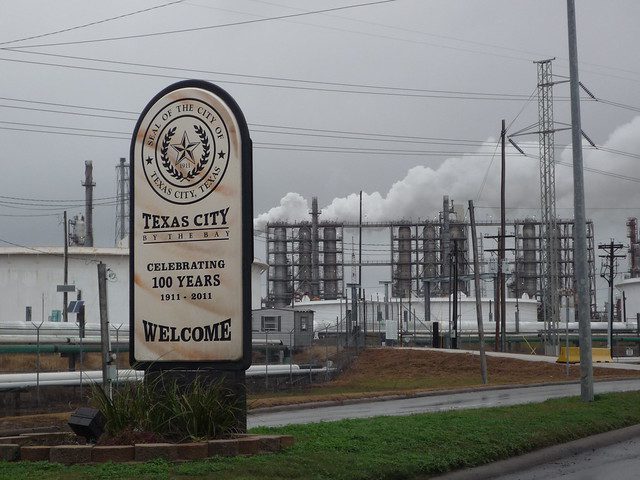
– 
– 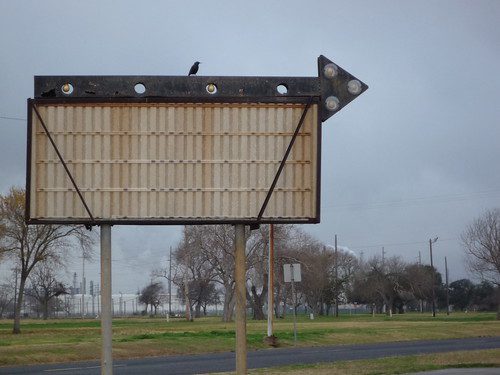
– 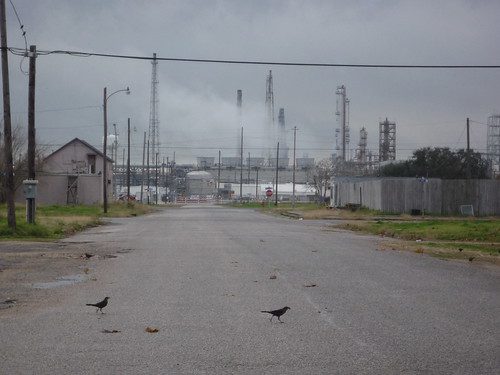
– 
– 
Texas City, from the 5 Mile Dike. ***
Jan 05 Galveston, The Ocean Star Offshore Rig and Museum. Everything you always wanted to know about offshore drilling but were afraid to find out. Fantastic. A working rig, fully labeled; costumes to try on (“so you want a job in offshore?”; personality tests; brass plaques; miniatures; a dizzying derrick; 3D displays of seismic geological detection; an extensive “life on the offshore rig” display; and a corner of the 2nd floor devoted to environmental consciousness and care.

– 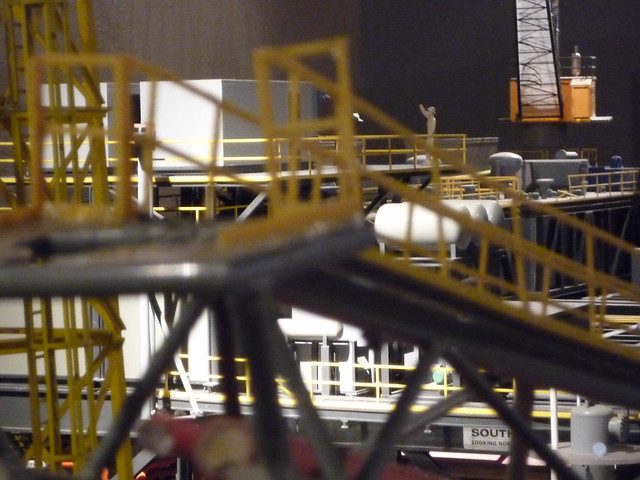
– 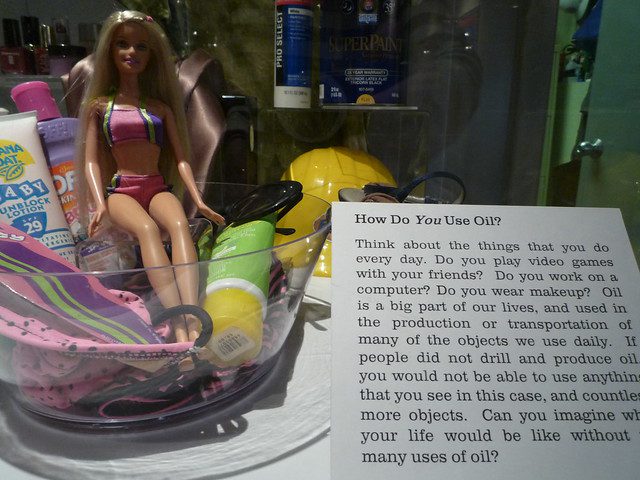
– 
The Ocean Star Offshore Rig and Museum. ***
Jan 05 Peak experience of the day: driving back from Galveston along the service road of I-45. Just before the causeway back to the mainland, one passes a series of wetlands, called the John M O’Quinn Estuarial Corridor. pull over, as I see birds paddling about. Texas is the #1 birding state apparently. And they are everywhere, squeaking, cawing, peeping, singing, wading, flapping, drying out. But here… so poetic: just beyond the meandering estuary is a long line of freight cars, all oil tanks, and beyond that, the refineries of Texas City. And up in the sky is something pink, the color of sunset (really), I am thinking flamingo, it’s so pink. It’s a roseate spoonbill, it’s exquisite, alone, and flapping its pinkness across the late afternoon.

– 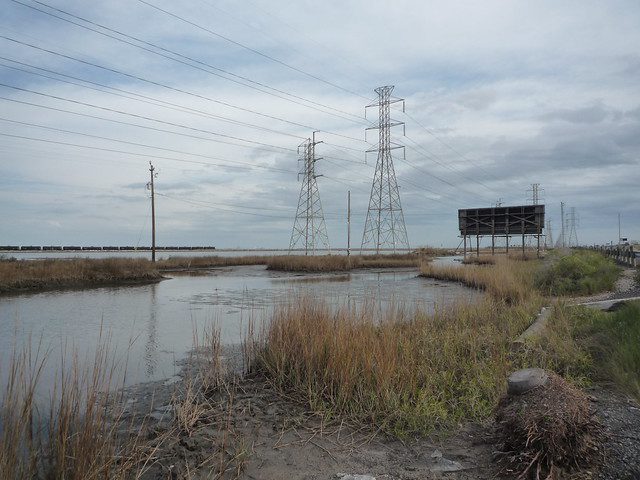
– 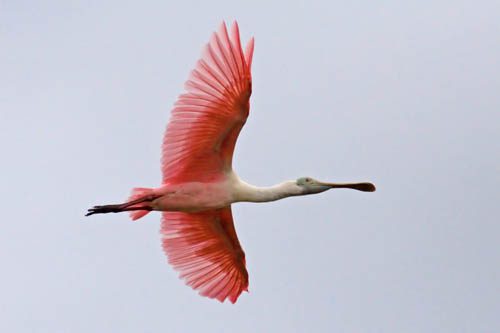
The John M. O’Quinn Estuarial Corridor, Roseate Spoonbill ***
Jan 06 Went to The Center for Land Use Interpretation’s (CLUI) exhibition down on Buffalo Bayou. They have an exhibition and workspace trailer on the Buffalo Bayou Partnership land, next to a “symphonic” scrap yard. The aerial HD video that CLUI made for “Texas Oil: Landscape of an Industry” is stunning. And in the last CLUI’s newsletter, the essay “Going With The Flow, Flowing Through Texas’ Liquid Petrochemicalscape” reads like adventure fiction.
On the exhibition site at the Blaffer, CLUI writes
A petrochemical system integrates the country through a continental network of facilities and pipelines. This network, assembled over the last hundred years, moves crude, gas, and chemical feedstock, from coast to coast, production areas to processing plants, tank farms to tanker ports, touching every state. It is a circulatory system of the American Land, moving the lifeblood of the economy, in this Petrochemical Age. Though the complexity, scale, and forms of the industry resemble those of science fiction fantasy, they are real and present. If the oil industry has a heart, then it is Texas. And Houston is its aorta.
— The Center for Land Use InterpretationCLUI: http://www.clui.org/pro_pro/exhibits/txoil.html

– 
– 
– ******************************************************************
Also –
- Great (toxic Texas?) oysters at Shrimp n Stuff for lunch. Highly recommend you get your lunch on there. Great fish tacos, too.
- Lovely meeting Mary Magsamen of Aurora Picture Show that night…
- Kurt Schwitters’ Merzbau reconstructed at the Menil
- Also at the Menil was the exhibition “Witnesses to a Surrealist Vision,” which besides many great gems of the movement, presented a room of objects the surrealists had or would have had to inspire them. These included: “coconut seed resembling buttocks;” “Mickey Mouse Kachina;” and “Pestle in the Form of a Phallus.” 133 objects in total, organized by anthropologist Edmund Carpenter.
- Got to hang out with Diane Barber, curatrix extraordinaire, her partner Karen and her 2 dog-buds Bosco and Domino.
all flickr pics at http://www.flickr.com/photos/22155573@N00/

Kurt Schwitters. The Merzbau, transformation of six (or possibly more) rooms of the family house in Hannover, Waldhausenstrasse 5. This took place very gradually; work started in about 1923, the first room was finished in 1933, and Schwitters subsequently extended the Merzbau to other areas of the house until he fled to Norway in early 1937 -
January 6, 2011
Plague proportions
Tags:
Image: Inquistr It is difficult not to respond with a biblical chill to the confluence of reports; and no answers – even all disparate causes – are going to be an enormous relief, either.
Wildlife officials say that even more previously unreported dead birds were found in Kentucky last week.
Millions of dead fish surfaced in Maryland’s Chesapeake Bay in the U.S., Tuesday, while similar unexplained mass fish deaths occurred across the world in Brazil and New Zealand. On Wednesday, 50 birds were found dead on a street in Sweden. The news come after recents reports of mysterious massive bird and fish deaths days prior in Arkansas and Louisiana.
The Baltimore Sun reports that an estimated 2 million fish were found dead in the Chesapeake Bay, mostly adult spot with some juvenile croakers in the mix, as well. Maryland Department of the Environment spokesperson Dawn Stoltzfus says “cold-water stress” is believed to be the culprit. She told The Sun that similar large winter fish deaths were documented in 1976 and 1980.
ParanaOnline reports that 100 tons of sardines, croaker and catfish have washed up in Brazilian fishing towns since last Thursday. The cause of the deaths is unknown, with an imbalance in the environment, chemical pollution, or accidental release from a fishing boat all suggested by local officials.
In New Zealand, hundreds of dead snapper fish washed up on Coromandel Peninsula beaches, many found with their eyes missing, The New Zealand Herald reports. A Department of Conservation official allegedly claims the fish were starving due to weather conditions.
While all three events are likely unrelated, they come after recent reports of mysterious dead birds falling from the sky in both Arkansas and Louisiana. Thousands of dead birds were found in Beebe, Arkansas on New Year’s Eve, and a few days later, around 500 of the same species were found 300 miles south in Louisiana. A Kentucky woman also reported finding dozens of dead birds scattered around her home. In the days prior to New Year’s, nearly 100,000 fish surfaced in an Arkansas river 100 miles west of Beebe.
From the Huffington Post – Dead Birds Fall From Sky In Sweden, Millions Of Dead Fish Found In Maryland, Brazil, New Zealand.
All Huffington Post bird tags: http://www.huffingtonpost.com/tag/birds-fall-from-sky
Addendum:
Track Recent Animal Deaths with Google Maps
-
January 3, 2011
invasivores.
Tags:From the NY Times, Jan 2, 2011:
A Diet for an Invaded Planet: Invasive Species
There’s a new shift in the politics of food, not quite a movement yet, more of an eco-culinary frisson. But it may have staying power; the signs and portents are there. Vegans, freegans, locavores — meet the invasivores.
Some divers in the Florida Keys recently held a lionfish derby, the idea being to kill and eat lionfish, an invasive species. Local chefs cooperated by promoting the lionfish as a tasty entree. The idea drew editorial support from Andrew Revkin in a post on The Times’s Dot Earth blog in which he also mentioned an attempt by some fisheries biologists to rename the invading Asian carp “Kentucky tuna” to make it more appealing to diners. And the Utne Reader recently ran an article about Chicago chefs turning their attention to the same invasive fish.
The rumblings go further back, of course, as rumblings always do. The idea of eating kudzu and the recipes for it have been around for decades. More recently, at the beginning of 2009, a San Francisco blogger on matters ecological, animal and political, Rachel Kesel, posted a nicely turned argument for the “invasive species diet.”
Ms. Kesel, who grew up with a father who hunted deer, is now a vegetarian, but she included animals as well as plants in her proposed diet. She said in an interview that she was studying in London when she wrote the post, which grew out of conversations about diet and ecology. “If you really want to get down on conservation you should eat weeds,” she decided. And so she blogged.
She now works for the parks department of San Francisco and said she did indeed pursue the vegetable side of the diet she proposed. “I’m really looking forward to some of our spring weeds here,” she said, notably Brassica rapa, also known as field mustard or turnip mustard.
Ms. Kesel has a flair for the kind of rhetoric that any movement needs. “I’m almost serious here,” she concluded her diet post. “Eat for the environment. Eat locally. Eat wild meat. Eat for habitat. Eat invasive.”
Jackson Landers, unlike Ms. Kesel, is completely serious. As the Locavore Hunter, based in Virginia, he teaches urbanites how to hunt and butcher deer. He has branched out from the locavore life to invasives… What if we developed a similar taste for starlings?
I was pleased to see Canada geese and pigeons included in his list, because in the Northeast, neophyte invasivores face some unappetizing possibilities, like the zebra mussel (too little meat and too much salmonella) and the unpleasant and unwanted freshwater algae, Didymosphenia geminata, commonly called didymo, or, with absolutely no trace of affection, rock snot.
I don’t see the beginning of a menu there. But if we broaden the definition of invasives to include the things that invade the average suburbanite’s yard and golf course, a world of possibilities open up — deer, raccoons, opossums, squirrels, skunks, rabbits and woodchucks.
-
December 28, 2010
drawings dec 2010
-
-
-
-
December 21, 2010
The crucial role cities can play in protecting the honeybee | Rosie Boycott | Environment | guardian.co.uk
Tags:a year of continued and frightening environmental degradation and the looming prospect of severe food shortages in years to come. It is the image of workers in the Maoxian county of Sichuan, China, an area that has lost its pollinators through the indiscriminate use of pesticides and the over-harvesting of its honey. These workers aren’t picking fruit, or digging, or planting. They’re pollinating pear and apple trees by hand. In this part of China, the honeybee has been replaced by the human bee.
I learned about this startling practice this year, but in fact its been going on for the past two decades. Every spring, thousands of villagers climb through fruit trees hand-pollinating blossoms by dipping “pollination sticks” (brushes made of chicken feathers and cigarette filters) into plastic bottles of pollen and then touching them against each of the tree’s billions of blossoms.
One-third of all our food staples only grow after pollination. In the United States alone, the cost of replacing this “free service” which nature has provided for hundreds of thousands of years, is put at anything between £14bn and £92bn. And that’s in one country alone. If we don’t wake up to the global crisis facing our pollinators, the banking crisis is going to look relatively trivial as the world runs out of food. China can, for the time being, afford to hurl this level of human labour at the problem: but short of the prospect of actual starvation, it is wholly unrealistic to imagine this happening in, say, California, where bees still pollinate orange, apple, pear and plum trees.
-
